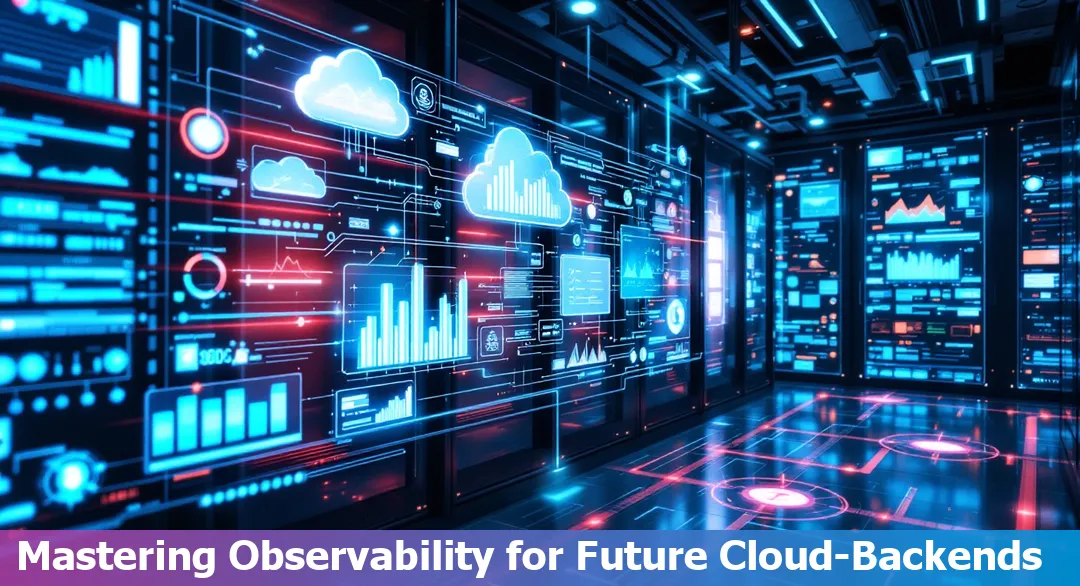The Role of Observability in Cloud-Native Backend Development in 2025
Last Updated: February 14th 2025

Too Long; Didn't Read:
In 2025, observability is essential in cloud-native backend development, enabling proactive issue detection with AI analytics and OpenTelemetry. Teams resolve problems 57% faster, benefiting from real-time monitoring, improved system reliability, and efficient resource use. The observability market is booming, with 88% of organizations embracing full-stack solutions, cutting problem-solving time by 30% and increasing system uptime by 25%. Integration with security practices further enhances system resilience, while AI reduces alert noise by 60%, making advanced tools accessible to smaller teams.
In 2025, observability is absolutely essential for cloud-native backend development. As recent research shows, it's the power to understand complex systems by analyzing their outputs, helping developers quickly spot and fix issues before they become problems.
Modern observability tools now automatically collect and process infrastructure data, making it easier than ever to maintain reliable systems.
Three major developments are shaping the field: AI-powered analytics that predict problems before they happen, OpenTelemetry becoming the go-to standard for data collection, and real-time monitoring that's changing how we handle system performance.
Teams using these tools are fixing issues 57% faster than before. Cloud-native observability has evolved to include comprehensive monitoring of containers, microservices, and serverless functions, with a focus on automating response protocols.
The result? Better system reliability, faster problem-solving, and more efficient resource use. As backend systems get more complex, having solid observability isn't just nice to have - it's crucial for staying ahead in tech.
Table of Contents
- Key Technologies Revolutionizing Observability
- Market Growth and Economic Impact
- Integration with Security Practices
- Challenges and Future Predictions
- Frequently Asked Questions
Learn how AI and ML automate backend processes to create more efficient systems in 2025.
Key Technologies Revolutionizing Observability
(Up)Cloud-native observability is getting a major upgrade in 2025, and I'm honestly excited about how OpenTelemetry and AI are transforming the landscape.
The data explosion is real - we're talking about over 200 zettabytes of global data storage expected by 2025. That's mind-blowing! AI and ML aren't just buzzwords anymore; they're essential tools for making sense of all this telemetry data.
What's super cool is that they're actually helping developers catch issues before they become problems.
OpenTelemetry is becoming the go-to standard for collecting and processing observability data, with major players like Chronosphere, New Relic, and Splunk fully backing it.
The best part? It's totally vendor-neutral, which means no more getting stuck with one provider. The stats are pretty impressive too - we're seeing a 45% year-over-year increase in code commits on GitHub, showing just how much the dev community is investing in this technology.
What's really getting attention is how observability is shifting both left and right in the development cycle.
This means developers can spot issues early in development and also keep an eye on edge computing environments. Real-time monitoring is becoming more accessible, and with AI handling the heavy lifting of data analysis, we're looking at faster, more reliable systems.
Plus, with new certification programs launching in 2025, it's clear that OpenTelemetry skills are going to be super valuable for anyone in tech.
Market Growth and Economic Impact
(Up)The observability market is growing faster than expected, with projections reaching $2.4 billion by 2024 and showing a steady 8.4% growth rate through 2034.
This expansion is seriously transforming how businesses handle their tech operations. What's really interesting is how companies are shifting from just watching for problems to actually preventing them, using AI-powered systems to catch issues before they mess things up.
The numbers are pretty clear - implementing these tools cuts down problem-solving time by 30% and saves companies major cash on operational costs. It's honestly mind-blowing how much difference it makes.
One thing that's totally changed the game is how organizations approach cost management.
Companies are getting smarter about their tech spending, focusing on solutions that give them the freedom to mix and match different tools. About 88% of organizations are now going all-in on full-stack observability, which is a huge jump from where we were just a year ago.
The best part? These tools are actually paying for themselves - businesses are seeing up to 25% better system uptime, which directly impacts their bottom line.
Looking at the real impact, organizations using these tools are crushing it with faster problem-solving and way better system reliability.
The tech helps teams spot potential problems early, saving tons of time and resources that would've been wasted on firefighting later. Plus, with the whole work-from-anywhere situation still going strong in 2025, having solid observability tools isn't just nice to have - it's absolutely essential for keeping everything running smoothly.
Integration with Security Practices
(Up)In 2025, merging security with observability in cloud-native backend development isn't just smart - it's absolutely essential. Security observability has become a game-changer, letting organizations catch and fix issues before they blow up into major problems.
According to recent findings, organizations implementing unified data observability platforms are seeing massive improvements in their security stance, with predictive capabilities now enabling teams to spot and resolve issues before they escalate.
What's really cool is that by 2025, about 70% of enterprises will have deployed these solutions, cutting downtime by up to 40%. The integration is seriously revolutionizing how we handle security threats - it's like having a high-tech early warning system that never sleeps.
Here's why this matters:
- Proactive Defense: Real-time monitoring catches threats before they become disasters.
- Smart Cost Management: AI-powered tools cut down on false alarms, saving both time and money.
- Easier Compliance: Automated tracking makes regulatory requirements way less painful.
What's really interesting is how OpenTelemetry is becoming the standard for collecting and analyzing security data.
By making everything work together seamlessly, it's helping teams build stronger, more resilient systems without breaking the bank. The best part? This isn't just another tech trend - it's completely changing how we approach security in cloud environments.
As someone diving into backend development, this integration of security and observability is basically becoming our new superpower for building safer, more reliable systems.
Challenges and Future Predictions
(Up)As a backend developer diving into cloud-native environments in 2025, I'm amazed at how data overload has become our biggest challenge.
The numbers are mind-blowing - we're looking at 70% more telemetry data compared to 2023, and honestly, it's getting harder to find the important stuff in all that noise.
But here's the cool part: we're seeing some seriously smart solutions pop up. Like, imagine having AI that automatically filters out the unnecessary data while keeping the crucial metrics.
According to recent predictions from Dynatrace, organizations are shifting towards preventive observability, which is basically catching problems before they blow up.
One thing that excites me is how AI is changing the alert game.
I mean, getting bombarded with false alerts is such a pain, right? But now, Grafana Labs' latest research shows that machine learning algorithms are cutting down alert noise by like 60%.
That's huge! These systems are getting super smart at understanding what's actually important versus what's just regular system behavior. The best part? They learn from past incidents, so they get better at predicting issues over time.
What's really changing the game is how these tools are becoming available to everyone, not just the big tech companies.
Back in the day, you needed deep pockets for this kind of tech, but now smaller teams can access the same powerful tools. It's pretty awesome to see how observability is evolving to help us build more reliable systems.
As someone just starting in this field, it's definitely an exciting time to be working with these technologies.
Frequently Asked Questions
(Up)Why is observability crucial for cloud-native backend development in 2025?
In 2025, observability is essential for understanding complex systems in cloud-native backend development. It helps developers quickly identify and fix issues, preventing them from becoming major problems. This is crucial for maintaining system reliability, speeding up problem-solving, and ensuring efficient resource use.
What major developments are shaping observability in 2025?
Three major developments shaping observability in 2025 include AI-powered analytics for predictive issue detection, the adoption of OpenTelemetry as the standard for data collection, and enhanced real-time monitoring. These advancements are helping teams resolve issues 57% faster and improve system performance and reliability.
How is observability being integrated with security practices?
In 2025, integrating observability with security practices is vital for proactively defending against threats. Real-time monitoring and AI-powered tools enhance security by quickly identifying and resolving issues before they escalate, reducing downtime by up to 40% and improving compliance with regulatory requirements.
What is the economic impact of observability on businesses by 2025?
The observability market is growing rapidly, transforming business operations by reducing problem-solving time by 30% and saving on operational costs. Full-stack observability adoption has increased significantly, leading to improved system uptime and direct positive impacts on company financials.
How is AI enhancing observability in backend development?
AI is revolutionizing observability by filtering out unnecessary data and reducing alert noise by 60%. These machine learning algorithms learn from past incidents to better predict issues, making observability tools more accessible and helping smaller teams build reliable systems.
Understand the Role of Containerization and Orchestration in boosting efficiency for large-scale applications.
Ensure your APIs are well-documented with comprehensive documentation that facilitates seamless user experience and security.
Understand the benefits of loose coupling and scalability provided by embracing event-driven architectures.
Gain a competitive edge by utilizing Dynatrace and Codefresh Tools to optimize your backend performance in 2025.
Join us in an Exploration of CI/CD tools such as Jenkins and CircleCI that are pivotal for Python-based backend efficiency.
Dive into data scalability techniques such as sharding and caching to manage expansive datasets efficiently.
Explore emerging players like Peewee and PonyORM and see how they're reshaping the ORM landscape.
The marriage of Python and TensorFlow Lite integration is setting new standards for mobile machine learning models.
Ludo Fourrage
Founder and CEO
Ludovic (Ludo) Fourrage is an education industry veteran, named in 2017 as a Learning Technology Leader by Training Magazine. Before founding Nucamp, Ludo spent 18 years at Microsoft where he led innovation in the learning space. As the Senior Director of Digital Learning at this same company, Ludo led the development of the first of its kind 'YouTube for the Enterprise'. More recently, he delivered one of the most successful Corporate MOOC programs in partnership with top business schools and consulting organizations, i.e. INSEAD, Wharton, London Business School, and Accenture, to name a few. With the belief that the right education for everyone is an achievable goal, Ludo leads the nucamp team in the quest to make quality education accessible
